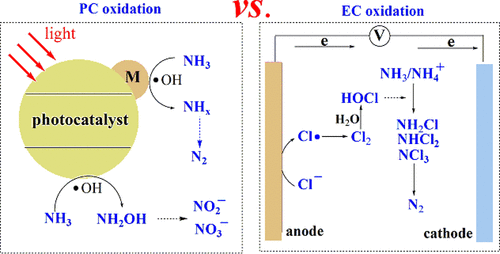当前位置:
X-MOL 学术
›
ACS ES&T Eng.
›
论文详情
Our official English website, www.x-mol.net, welcomes your feedback! (Note: you will need to create a separate account there.)
Recent Advances on Photocatalytic and Electrochemical Oxidation for Ammonia Treatment from Water/Wastewater
ACS ES&T Engineering Pub Date : 2020-12-06 , DOI: 10.1021/acsestengg.0c00186 Guan Zhang 1, 2 , Juzhuan Ruan 1 , Tingting Du 1
ACS ES&T Engineering Pub Date : 2020-12-06 , DOI: 10.1021/acsestengg.0c00186 Guan Zhang 1, 2 , Juzhuan Ruan 1 , Tingting Du 1
Affiliation

|
Heterogeneous photocatalytic (PC) and electrochemical (EC) oxidation of ammonia/ammonium pollutants in water/wastewater have been thoroughly investigated for ammonia abatement from aqueous streams, as there are continuing needs for developing alternative on-site easily controllable treatment approaches in contrast to conventional methods. Depending on the contamination level, water matrix characters, and regulatory consideration, the PC and EC oxidation of wastewater pollutants or integration with other treatment processes exhibit their own advantages and disadvantages at specific conditions. The PC oxidation of ammonia primarily relies on in situ generated strong oxidants such as hydroxyl radicals and holes, but their reactivities with ammonia are relatively slower at environmentally relevant pH conditions. In contrast, indirect EC oxidation of ammonia based on active chlorine species is more efficient and exhibits some advantages compared to the chemical chlorination approach. Although we have gained much scientific knowledge on this research topic in recent years, the research so far has not yet lead to broad industry adoption due to the many concerns about technical drawbacks and economic feasibilities; hence, it is necessary to reexamine the efforts made in this field. Upon survey of the recent literature, the aim of this review is to summarize and discuss the recent achievements and key issues on the PC and EC driven oxidation processes for ammonia abatement in order to avoid redundant studies that concentrate on well-established issues and point out the research directions to move these techniques forward in future.
中文翻译:

光催化和电化学氧化处理水/废水中氨的最新研究进展
已对水/废水中氨/铵污染物的异质光催化(PC)和电化学(EC)氧化进行了彻底研究,以消除水流中的氨,因为与常规方法相比,仍需要开发其他易于控制的现场处理方法方法。根据污染水平,水基质特征和法规考虑,废水和污染物的PC和EC氧化或与其他处理工艺的结合在特定条件下各有其优缺点。氨气的PC氧化主要依赖于原位生成强氧化剂,例如羟基自由基和空穴,但它们在环境相关的pH条件下与氨的反应性相对较慢。相比之下,与化学氯化法相比,基于活性氯物质的氨进行间接EC氧化更为有效,并显示出一些优势。尽管近年来我们已经在这一研究主题上获得了很多科学知识,但是由于对技术缺陷和经济可行性的许多担忧,到目前为止,该研究尚未导致广泛的行业采用。因此,有必要重新审视在这一领域所做的努力。回顾最近的文献,
更新日期:2020-12-06
中文翻译:

光催化和电化学氧化处理水/废水中氨的最新研究进展
已对水/废水中氨/铵污染物的异质光催化(PC)和电化学(EC)氧化进行了彻底研究,以消除水流中的氨,因为与常规方法相比,仍需要开发其他易于控制的现场处理方法方法。根据污染水平,水基质特征和法规考虑,废水和污染物的PC和EC氧化或与其他处理工艺的结合在特定条件下各有其优缺点。氨气的PC氧化主要依赖于原位生成强氧化剂,例如羟基自由基和空穴,但它们在环境相关的pH条件下与氨的反应性相对较慢。相比之下,与化学氯化法相比,基于活性氯物质的氨进行间接EC氧化更为有效,并显示出一些优势。尽管近年来我们已经在这一研究主题上获得了很多科学知识,但是由于对技术缺陷和经济可行性的许多担忧,到目前为止,该研究尚未导致广泛的行业采用。因此,有必要重新审视在这一领域所做的努力。回顾最近的文献,


























 京公网安备 11010802027423号
京公网安备 11010802027423号